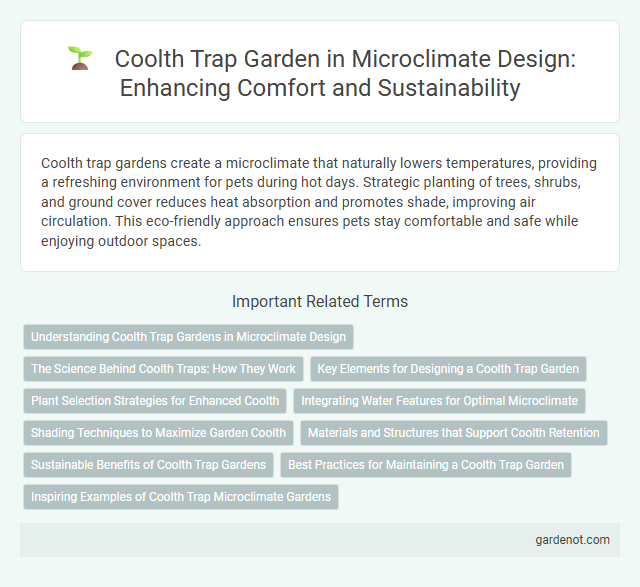Coolth trap gardens create a microclimate that naturally lowers temperatures, providing a refreshing environment for pets during hot days. Strategic planting of trees, shrubs, and ground cover reduces heat absorption and promotes shade, improving air circulation. This eco-friendly approach ensures pets stay comfortable and safe while enjoying outdoor spaces.
Understanding Coolth Trap Gardens in Microclimate Design
Coolth trap gardens strategically utilize shade, vegetation density, and water features to reduce ambient temperatures within microclimates. By harnessing evaporative cooling and obstructing heat radiation, these gardens create localized cool zones that enhance thermal comfort in urban spaces. Integrating native plants with high transpiration rates optimizes the coolth-trapping effect and promotes sustainable microclimate management.
The Science Behind Coolth Traps: How They Work
Coolth trap gardens utilize natural principles of heat transfer and thermal radiation to lower ambient temperatures in targeted areas. These gardens often employ materials with high thermal emissivity and strategic shading to absorb and dissipate heat effectively, creating cooler microclimates for plants and people. By enhancing evaporative cooling and reducing direct solar radiation, coolth traps optimize local temperature regulation, supporting plant health and energy efficiency in urban environments.
Key Elements for Designing a Coolth Trap Garden
Key elements for designing a coolth trap garden include strategic placement of dense vegetation to enhance shade and reduce ambient temperatures. Incorporating water features such as ponds or fountains promotes evaporative cooling, while using materials with high thermal mass helps absorb and gradually release heat, maintaining a stable microclimate. The orientation and layering of plants optimize airflow and sunlight exposure, contributing to an efficient and sustainable coolth trap system.
Plant Selection Strategies for Enhanced Coolth
Selecting drought-tolerant, deciduous trees like honey locust and American hornbeam creates dense shade that reduces ground temperature in a coolth trap garden. Incorporating ground covers such as creeping thyme and native ferns helps maintain soil moisture and enhances evapotranspiration, increasing localized cooling effects. Strategically planting deep-rooted shrubs like elderberry and sumac improves soil structure, promotes airflow, and supports sustained cool microclimates.
Integrating Water Features for Optimal Microclimate
Integrating water features in a coolth trap garden enhances evaporative cooling, significantly reducing ambient temperatures by up to 5degC. Strategically placed ponds, fountains, or misting systems increase local humidity and promote airflow, creating a more comfortable microclimate. Incorporating native aquatic plants further stabilizes temperature fluctuations and supports biodiversity within the garden ecosystem.
Shading Techniques to Maximize Garden Coolth
Shading techniques in a coolth trap garden significantly reduce soil temperature and evapotranspiration, enhancing plant comfort and growth. Utilizing strategically placed trees, pergolas, and shade cloths creates microclimates that block direct sunlight during peak heat, maintaining cooler ambient temperatures. Incorporating vertical gardens and reflective mulches further maximizes shading efficiency, promoting moisture retention and reducing heat stress on plants.
Materials and Structures that Support Coolth Retention
Materials such as high thermal mass stones, porous bricks, and water-retentive soil compositions support coolth retention by absorbing and slowly releasing heat, maintaining lower temperatures in microclimate gardens. Structural elements like shaded pergolas, dense plant canopies, and strategically placed reflective surfaces reduce solar radiation exposure and promote natural cooling through evapotranspiration. Incorporating mulches, green roofs, and insulated garden walls further enhances temperature moderation by minimizing heat absorption and maximizing moisture retention within the garden space.
Sustainable Benefits of Coolth Trap Gardens
Coolth trap gardens enhance sustainability by reducing urban heat island effects and lowering energy consumption through natural temperature regulation. These gardens increase biodiversity by providing habitats for various plant and insect species, promoting ecological balance. Water conservation is improved as coolth traps reduce evaporation rates, contributing to efficient resource management in drought-prone areas.
Best Practices for Maintaining a Coolth Trap Garden
Maintaining a Coolth Trap garden involves strategically planting drought-tolerant species and utilizing mulch to retain soil moisture while minimizing heat absorption. Regular monitoring of soil temperature and humidity levels ensures optimal microclimate conditions that enhance plant resilience during heat waves. Incorporating shade structures and reflective surfaces further reduces ambient heat, promoting a balanced and sustainable garden environment.
Inspiring Examples of Coolth Trap Microclimate Gardens
Coolth trap microclimate gardens leverage strategic planting, shade structures, and water features to create natural cooling zones in urban environments. Notable examples include Singapore's Gardens by the Bay, where vertical greenery and misting systems reduce ambient temperatures, and Los Angeles' urban parks that integrate drought-tolerant vegetation and reflective surfaces to minimize heat absorption. These designs exemplify innovative approaches to mitigating urban heat islands while enhancing biodiversity and human comfort.
Coolth trap garden Infographic

 gardenot.com
gardenot.com